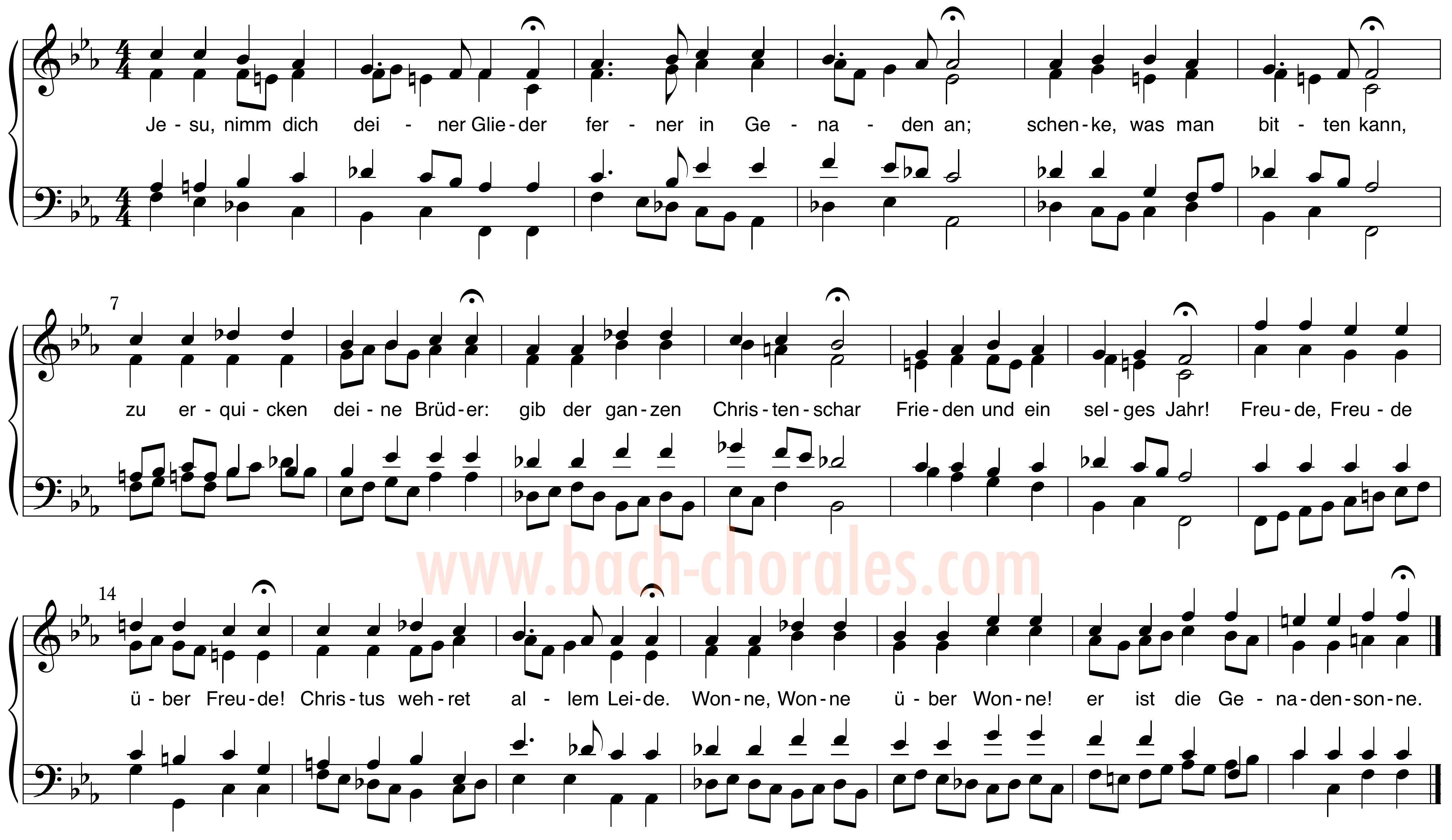 |





|
BWV 40.8

Previous: BWV 40.6
Next: BWV 41.6
Original source: Cantata, Dazu ist erschienen der Sohn Gottes, BWV 40 (bach–digital page)
Chorale Text: Freuet euch, ihr Christen alle (verse 4), by Christian Keymann (1646)
Tune: Freuet euch, ihr Christian alle, by Andreas Hammerschmidt (1646) (Zahn 7880a)
First Performance:26 December 1723, 2nd Day of Christmas
Appearance in Early Collections (Key): Riemenschneider 8; Breitkopf 8; Birnstiel 8; AmB 46II p.130; Levy–Mendelssohn 9; Fasch p.54
Other Harmonizations: None
Instrumentation: Colla parte — S: violin 1, oboe 1, horn 1. A: violin 2, oboe 2. T: viola. B: continuo.
Original manuscripts
Score: D–B Mus. ms. Bach P 63
Parts: D–B Mus. ms. Bach St. 11
Notes
Measures 2, 4, 6 & 16 of this chorale each contain parallel fifths between the soprano and the tenor where the former is a Re–Do anticipation figure and the latter is a delayed arrival of the seventh of a V7 chord. These "cadential parallels" are considered non–structural since they involve non–chord tones. Cadential parallels can be found in several chorales, though this chorale is the only setting to feature more than one instance.
While the cadential parallels in this chorale appear in the original manuscripts, they have been "corrected" in some of the 18th c. chorale collections assembled after Bach’s death. In the important Breitkopf edition published in the 1780s and edited primarily by C.P.E. Bach, three of the four cadential parallels have been rhythmically staggered by dotting the soprano anticipation figure (mm. 4, 6 and 16 below). The other instance of parallels in measure 2 have been eliminated entirely by removing the soprano’s anticipation figure altogether.
Breitkopf Edition, Volume 1 (1784)

Curiously, the editorial treatment of these cadential parallels is not consistent in all early chorale collections. At times, the parallels are corrected in different ways. At other times, the parallels are left uncorrected. In the AmB 46II manuscript, all four cadential parallels are staggered by dotting the tenor’s eighth notes (rather than the soprano’s anticipation figure). In the Fasch manuscript, the measure 2 and 16 parallels are left uncorrected while the measure 4 and 6 parallels are corrected as the Breitkopf corrects. These curious inconsistencies suggest at least a consistent editorial permissiveness.
Who exactly is responsible for these editorial emendations is unknown. Simply assuming that C.P.E. Bach as primary editor of the Breitkopf is the principal culprit fails to take into account other early chorale collections like the AmB 46II and Fasch manuscripts, both of which predate the Breitkopf and both which may have been edited by someone other than C.P.E. Bach. Other potential culprits include Kirnberger (who had a known association with "Anonymous J.S. Bach VI," the copyist of the AmB 46II manuscript), Marpurg (who edited the early parts of the 1765 Birnstiel publication which served as a template for the Breitkopf) and other former students of J.S. Bach who were perhaps interested in enhancing the legacy of their great teacher as a master contrapuntalist.
Apart from the emendations described above, the only other difference between these early chorale collections and the original manuscripts is the downward octave transfer of the bass in measure 7, beats 3 and 4. The Breitkopf, Fasch and Am B46II manuscripts (and presumably the Birnstiel and Spitta, to which I have no access) all include the octave transfer while the lower octave is nowhere found in the original score or parts, neither in the bass part nor in the continuo part.
For a complete account of consecutive fifths and octaves in the Bach chorales, see "Consecutive Fifths & Octaves in the Bach Chorales" featured on the Articles & Research page.
bach–chorales.com by Luke Dahn. Copyright 2018.